I am told Titanic Belfast has been voted the Number 1 Tourist Attraction in the World and when you see it you understand why. The attention to detail in this “state -of –the- art visitor experience” is impressive. They really want to convey to you what it was like for people in the times, before and during the building of the ship, the fitting out, the voyage and the aftermath.
There is a lot of explanation given for how the centre was designed. Essentially they have combined the concepts of the outline of a ship and the shape of an ice crystal. Inside on the ground floor is a compass and the route the ship was meant to take is highlighted in several places. There are 9 interactive galleries on 4 levels and from several places on levels 1, 2 and 3 you can look down to the ground floor. On the ground floor are the ticket office, two eating places, the gift shop, the help desk, and where you get your photo taken to be imposed on the background of the magnificent staircase. (As I do not think they would have allowed an old dame like me in jeans and a couple of very bulky warm jackets near that staircase I opted not to get the photo. Had they had the choice of say being beside a rail or at the bar it may have been another story -but there is only the one option.)
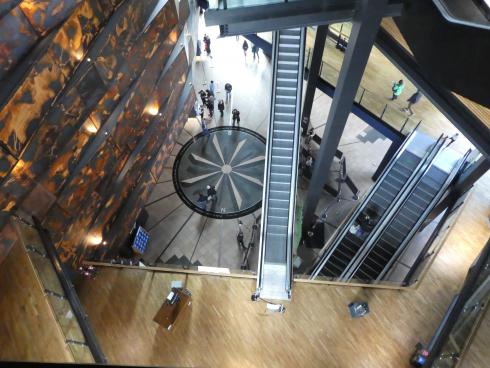

There are buildings outside as well – one a prayer room, another seems to be a conference/meeting room and then there are the large metal poles that mark where the Titanic and sister Olympic were built from the keel up. There is an underground car-park, bus parking, bus stops on one side and a taxi rank on another and lots of open space to wander with plenty of places to sit. I am told in warm weather the place is covered with people enjoying the space in the sun. (The day I was there most were like me - trying to find a building to put between them and the wintery gale that was blowing.) Locals can have a ‘day out’ and just wander around the park areas and on the ground floor free of charge and use the café and restaurant if they chose - and it seems many do. From the outside it is impressive and it is none the less inside.
Overall, it works very well. There are plenty of “crew” members to help, answer questions and overall ensure we all get to see it all at our own pace. In addition you can pay 3 pound and get an audio device and headphones and listen to the story as you go, as well as read all the panels and press all the interactive screens. There are also samples of the different type of carpets for you to feel, and swatches of the furnishing materials for you to examine and feel. I must say I was not sure if we were allowed to take photo's at first, so I took none at the beginning at all. It was not until I got to the launch area I found out we could so out came my camera then.
You start off on level 1 with what they call “Boomtown Belfast” when they set the scene for you as to what Belfast was like and why it was considered the best place to build the Titanic and its 2 sister ships Olympic and Britannic. With the magic of modern media you can “witness” a conversation between a couple of butlers, or you can even try your hand at the same Marconi devise used on the Titanic to transmit messages.
You then enter “The Shipyard” which while still on level one you can explore the blueprints and there are interactive screens to test your skills. You then go up in a workmen’s lift to level 4 and from here you are “at the top of the gantry” and you can look down from the top of the Arrol Gantry, with lots of noise to create the atmosphere of working in the shipyard. There is also what they refer to as “the ride’ which I did not do, which is a lot more realistic, but they do not take children, any sort of wheelchair and you can’t take any bags with you. My head was spinning after being that high and looking down, and there was a long queue waiting to do it, so I bypassed it.
The next section covers the Launch and you get to relive the excitement when it covered twice its length in 62 seconds when it was launched at 12.13pm on 31st May 1911. Over 100,000 people came to see it and they had erected special seating for the event - which was ticketed. The ship was then towed to the dry dock to be fitted out. I think it was from here that you had a glassed viewing area, which allowed you to look down on the area marked out where the Titanic and Olympic were built side by side and from where they were launched. (There were several of these and I was able to get nice shots of the area alongside and the hills in the distance.)
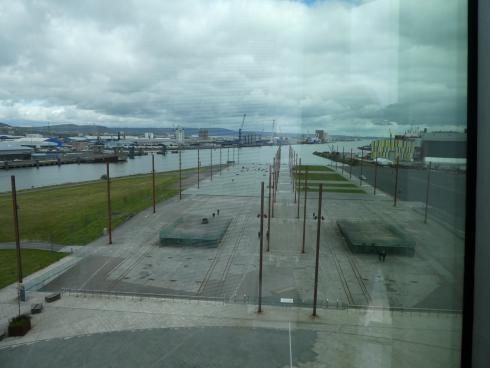
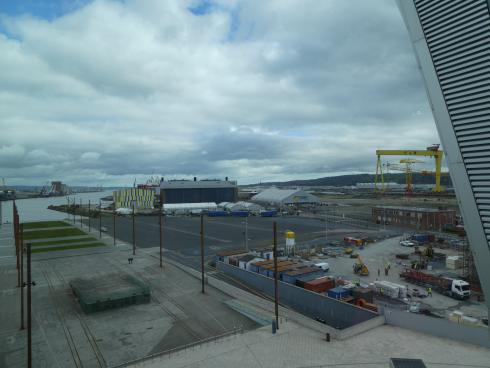
The next section – the Fit-out - was probably my favourite section. They have replicas of the first, second and third class cabins, with their electric lights (which would have been a novelty for many of the second and third class passengers) and the beds, upholstered chairs etc and all the fittings you would expect to find - including projected ‘figures’ going through the motions of life on board. I am afraid my photo's are not the best - but the best I could do in the circumstances with lots of glass walls and people also wanting to see. Hope you get a bit of an idea from them what it was all about.

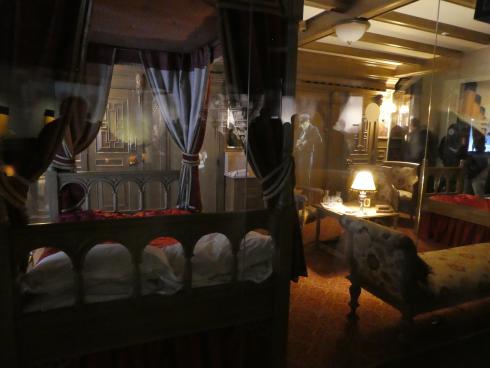
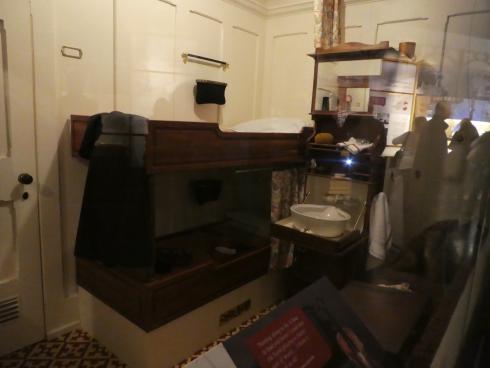
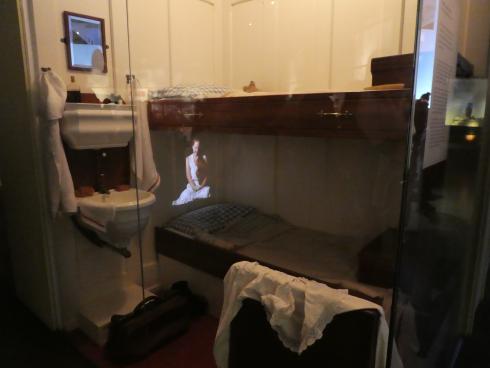
There are cabinets displaying the beautiful crockery, the background of the furniture builders and, can you believe, swatches of the fabrics used for the furnishings. They even have samples of the different types of carpet which you can feel and handle, They told you they carried 45,000 napkins and 18,000 bed sheets – in fact all the pieces of linen they needed for the journey - as there was no way to launder it on board. The bathroom fittings ‘rivalled those found in contemporary hotels of the time’ all being supplied by Royal Dalton and Shanks. I remember being told of the delight at finding everything new in second class, and how, just knowing it had not been used previously was a great thrill. How having everything with no chips or cracks or repairs or paint scratches was a really “big deal’. Seeing it all there, in the exhibit, brought this back to me.
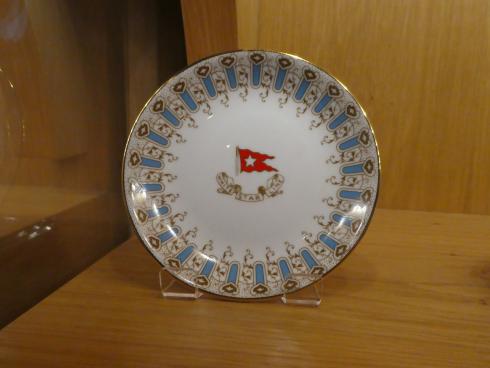
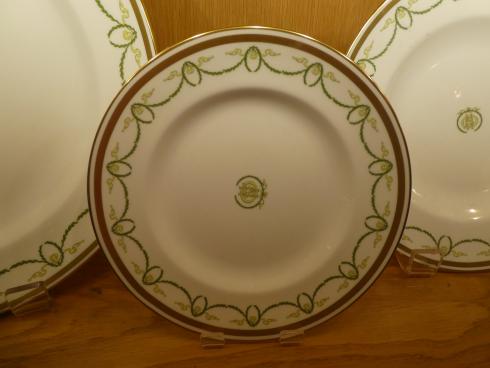
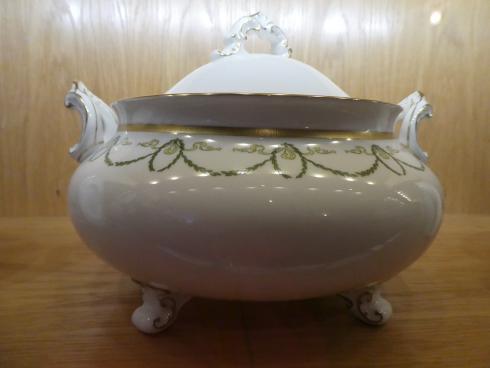
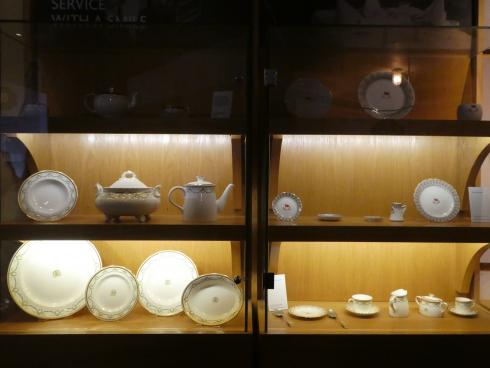
Did you know there were 6 pianos on the Titanic – all Steinways? Three “highly decorative” ones in First class, the grand piano with matching bench, music stands and cupboard was in the Reception room, and those in the Entrance Hall, and Dining Saloon were “decorated appropriate to their location”; as were the two in second class (in the Entrance and Dining Saloon) but just a standard Steinway in third class in the General room. (In third class, the families and single women and children ate in one area and the single men in another so the best place for the piano would have been the general area.)
There was a section you ‘walked in to’ and they had a movie showing on the three walls, whereby you got to experience the different levels and see the splendour of it. It started in the engine room and you can see (and hear) the motors, then up past some of the third and second class areas to the first class and get to move up that magnificent staircase, then up to the deck and finally the bridge. You also get to listen to the music of the Wallace Hartley’s Band - as they would have done on the voyage. Again my photo's are not great but the best I could get on the day. I hope they give you a bit of an idea what it felt like. I stood while it went through the program several times. These were the best I got.

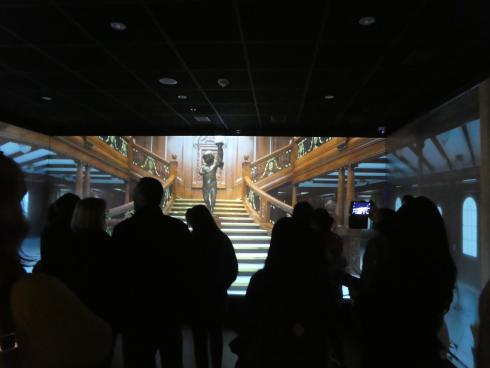
Behind the scenes was interesting too – they had the ability to carry 945 crew, but only had 885 on for that voyage, 61 deck crew (including the Captain) 317 Engine department and 507 what they called Victualling Department – cooks, stewards, waiters, barbers etc. Their cabin depended on their rank and job. Eg the Chief Engineer had a bedroom, sitting room and his own bathroom, while at the other end lesser ranks would share a dormitory style cabin with up to five others. There are even samples of the ropes for you to feel. By the time Titanic was built galvanised steel wire rope were mostly used for the mooring with Titanic using 18 to tie her to the wharf to ensure she did not move. Some Hemp and Manilla rope was also used for lesser weights and securing cargo.
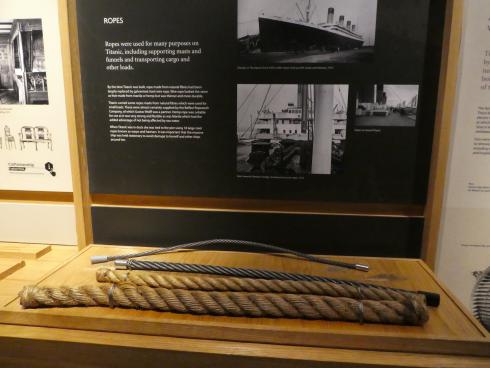
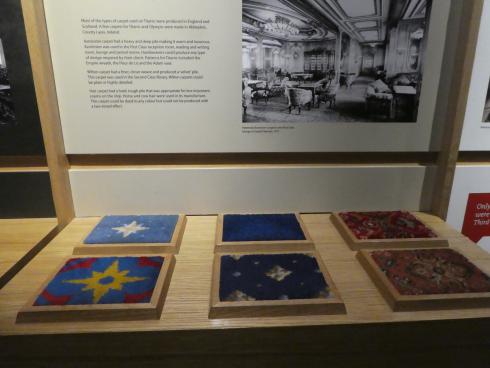
Then we move to the Maiden Voyage – still from the fourth level. Here you can follow its route from Belfast to Southampton, then to Cherbourg in France and finally Queenstown in Ireland and then to its final destination. There is a section that represents the deck and you can sit on the chairs, see the deck games, lean on the rail and feel the ‘pulse’ of the ship as it moves along. Through the glass doors you can ‘see’ a steward going about his duties. You get to see some of the photo’s taken by passengers who were on for the first part of the journey only, and there are copies of letters written by passengers, with comments from some of them about their journey to date. The entire section has the “air’ that this ship is the epitome of luxury and elegance and all that is great about ocean crossings.
The last section on this floor covers the Sinking. I found this very traumatic and took no photo’s here at all. It took me by surprise actually, but I think it is because I met two of the survivors when I was young. They were friends of my grandparents and my Nan persuaded them to talk to me about the experience. I was showing an interest in it (there had been an article about it in the Readers Digest that had sparked my interest) and although they did not usually talk about it to anyone much, they agreed to talk to me. I think perhaps I was about the same age they had been at the time. (They were children at the time, were both orphaned as a result, raised by relatives in the States, met at college, married, changed their name, and came to Australia where they ended up growing came outside Innisfail.) Anyway, I remembered the way they spoke of it as soon as I walked into that room. I got very emotional and spent little time there at all. You can listen to survivors tell their stories and ‘read all about it’ in the worlds press – but I did neither. I felt I had already heard all I needed to about this aspect. I did however scan the photo’s they had of some of the survivors to see if I could identify them, but to no avail.
From here you go down a level to the Aftermath. There is a full size replica of one of the lifeboats. You can hear some of the questions and testimony at the two inquiries into the sinking – one in England the other in the USA. I found it interesting, that it was said how many of the passengers refused to believe it was sinking, so would not get out of bed or done lifejackets or any such thing. The bandmaster and the band were made much of for having "played to keep the spirits up till the end". People said how they saw lots of people in the water but they were not asking for help or to be rescued so probably were already dead. It is interesting to note how recommendations from those enquires changed forever the way ships were fitted with lifeboats and the drill imposed, and safety at sea became a big thing for the future. You can also investigate to see if you have any links to any of the passengers. I spent some time looking through these and then remembered he said they had changed their name and migrated to Australia to put it all behind them.
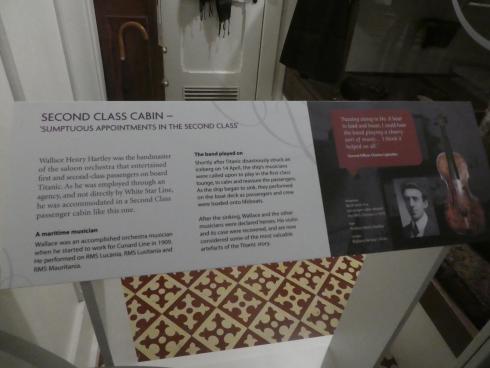
I found one interesting snippet here. The sister ship of the Titanic the Britannic never carried paying passengers. As War broke out while she was being fitted out, she became a hospital ship and was painted with lots of large red crosses. In 1916 she struck a mine and sank within an hour. There were only 30 loss of lives due to the better lifeboat drill, and the boat carrying more than 3 times the number of lifeboats as the Titanic. One of the survivors of the loss of the Britannic was Nurse Violet Jessop, who had been a steward on Titanic and survived it as well. How ironic is that?
Also on level 3 is the section they call “Myths and Legends” when they talk about the movies, stories, songs, poems that have been made/written about the loss of the Titanic. You can walk under Harland and Wolff Cranes – the firm thrived in the years after Titanic and continues to this day with its two large cranes called “Samson” and “Goliath” towering over the seaport not far from the Experience building. THEN if you are so inclined you can test your knowledge on an interactive quiz.
The last section is called “Titanic beneath and Ocean Exploration Centre.” Before you enter this, there is a TV screen where Dr Ballard talks of how his team came to find the wreck in 1985. They looked for and found the debris field first as it is much more widespread. (Probably many of you are like me and can remember the excitement of the discovery at the time.) You can then sit in a theatre and see it as it is now thought the means of the ROV – with several memorial plaques in place. You can then ‘explore’ the debris field yourself. Then stand on (or beside) a glass section as you ‘pass’ over the wreck as it is today. The front section is still very much intact with rails in place, and the Captains bathtub clearly visible and in situ as it was originally, but the stern has imploded and 10 stories compacted into one. Lastly you can explore domestic and international oceans and “see what life is beneath the surface of our local coastlines.” This was very popular with the kids/teenagers in particular, the day I was there. Personally, I think the wonderful ‘legacy’ of the Titanic story is the way the technological advances that were made for undersea exploration in order to find this wreck, have been adapted and improved and have opened up so many more opportunities to explore our seas and map our oceans. It is amazing how money can be found to chase dreams,that is not always available to advance science. This is one time the money spent on one has benefited the other.
Couple of other things I noted about the building – the 4 external entry/exit doors are on the four points of the compass, the Bistro 401 is named because as Titanic was being built this was her number in the shipyard. The Galley Café is a logical name I would contend for a Museum about a boat. There were unisex and disabled toilets on every level, but - the only negative point I found - there were not enough places for people to just ‘sit’ to contemplate and try to take in all they were seeing and experiencing. There is a lift to take you between floors if you were not up to doing the stairs. From several points you can look out and see the surrounding area and take photo’s of Belfast and the hills and the docks. The entire area is now referred to as the ‘Titanic Quarter” and there are other Titanic museums/events you can partake in. Incidentally that includes a huge sound stage – Titanic by name of course -and it is used for much of the Game of Thrones production as well as many others.
Entry to the Titanic Experience also entitles you to go over the SS Nomadic – the boat which was built to be the tender for the Titanic and Olympic in Cherbourg as this harbour was too shallow to allow them to come in close. They anchored in deeper water just offshore and the passengers were ferried to them by Nomadic.
It was built alongside Titanic in Belfast in 1911, was designed by Thomas Andrews and built using the same design and similar luxurious finishes to the Titanic although just one quarter of the size. It is interesting to note the comparisons with Titanic – the most telling for me is point 8. (I would have been interested to know the costs to build of both too.)
NOMADIC TITANIC
1. H&W Yard Number 422 401
2. Slipway Number 1 3
3. Time to Build 159 days 790 days
4. Length 233 feet 6 inches 882 feet 9 inches
5. Width 37 feet 2 inches 92 feet 6 inches
6. Number of funnels 1 4
7. Number of engines 2 3
8. Time in service 57 years (1911 – 1968) 13 days
9. Gross Tonnage 1273 46,328
10. Max Speed 12 knots 23.5 knots
*This information is from the Nomadic site.
Nomadic saw active service in both World Wars, over fifty years experience of carrying thousands of passengers to the world’s largest trans-Atlantic liners it then had nearly thirty years as a restaurant and party venue moored beside the Eiffel Tower in Paris.
It is the last remaining White Star Line ship anywhere in the world and a member of the core collection on the National Historic Ships register. Now back “home” in Belfast, after 100 years, Nomadic has been painstakingly restored to her original glory. Unfortunately by the time I got out of the Experience I had run out of time to view the Nomadic so I will have to save it for my next trip to Belfast. There was so much to try to take in I am sure I will be back again at some stage.
You can learn more at http://www.nomadicbelfast.comand more about the entire Titanic Quarter file://localhost/at http/::www.titanicbelfast.com if you are so inclined.
The most important aspect for me though was the number of Irish people (from both North and the Republic) who said how proud they were of Titanic Belfast, especially now it has been named “Number 1” and is bringing so many tourists to see it, but also many commented how it has renewed their pride in their Irish workmanship. They have done some wonderful work, and they still continue to do it, and it is good they have renewed pride in that. I think that is probably the best legacy of the Titanic story of all.

